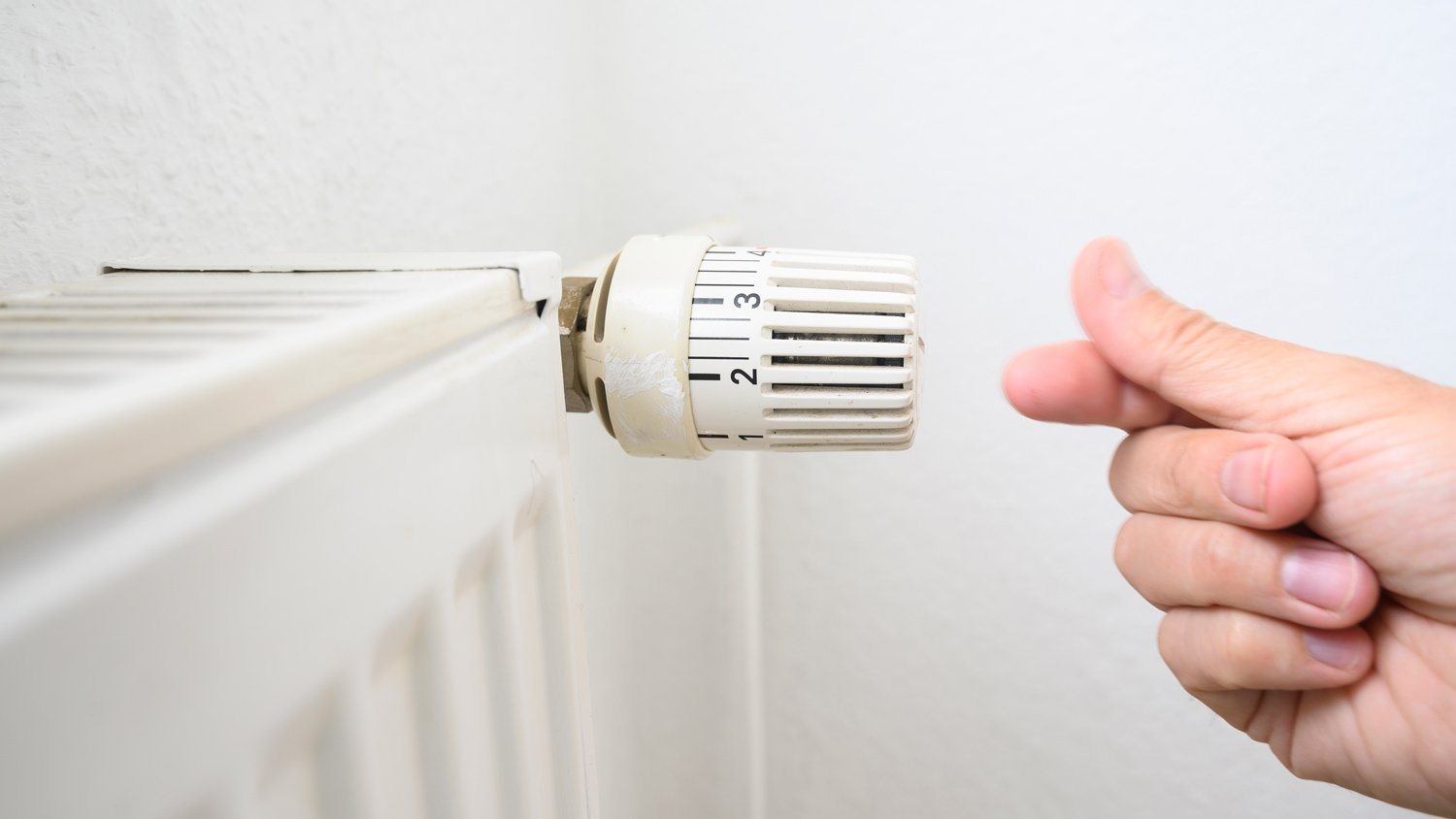How to Turn Off Baseboard Heaters: Gas and Electric
The basics of baseboard heating shutdowns


Learning how to turn off your baseboard heater is an essential part of adding this cozy feature to your home. Baseboard heaters provide direct heat to a room without the need for whole-house ductwork or vents. But if you don’t know how to turn it off, baseboard heaters can easily overheat a room or cause a fire hazard. Let’s review the best ways to turn off gas or electric baseboard heaters and when to hire a baseboard professional for help.
What Is a Baseboard Heater and Why Would I Need to Manually Turn It Off?

A baseboard heater is a single-room heater installed—you guessed it—next to the baseboards against the floor. Baseboard heaters can be electronic-, gas-, radiant hydronic-powered. This type of heater has some advantages, such as the ability to control the temperature in each room and skip ductwork and fan systems, which makes heating more efficient. But if you’re unfamiliar with baseboard heaters, it can be tricky to start using them, including learning how to turn them off.
Baseboard heaters don’t work with thermostats that control whole-house heating. Instead, they have separate thermostats or onboard knob controls, plus emergency shut-off options. That can lead to some confusion about how to shut them down. Baseboard heaters can also develop problems with overheating or refusing to shut down with normal controls.
How to Turn Off Your Baseboard Heater

If you’re struggling to turn off a baseboard heater, these steps should shut down electric- and gas-powered heaters.
Find and Lower the Baseboard Heater Thermostat
Many baseboard heaters have their own thermostat, which connects to baseboard heaters in a single or multiple rooms. You can find the thermostat mounted on a nearby wall or by the door to the room. The easiest way to turn off the heat is to adjust the thermostat at least several degrees down. After a few minutes, the baseboard heater should automatically shut off.
If the thermostat doesn’t work or leaves the baseboard heater on, it’s likely developed loose wiring contacts. That’s a warning sign that it's time for electrical repairs, but for now you can try to “tap the stat” or give it a good jiggle with your fingers. That can reconnect the electrical contacts, at least temporarily, and shut down the heater.
Use Knob Controls on the Top or Side of the Heater
Some baseboard heaters don’t have thermostats, but rather work with onboard knob controls built into the heater. Find these knob controls on the top or side of the baseboard heater. Try turning the knob counterclockwise to lower the heat and turn the heater off. Rotating clockwise will only increase the heater’s temperature.
Close Dampers to Diminish Convection Heating
Some types of baseboard heaters, especially convection versions, use dampers to control the amount of heat radiated into the air. To keep a room from overheating too easily, you can adjust the damper to a more narrow angle. Locate the screw on the side of the baseboard heater to manually tighten or loosen it to move the damper. You may have to take the cover off to find it.
Adjust Water Flow for Even Heating
If you have a hydronic baseboard heater, it may come with the option to control water flow from the boiler into the heater. If the heater is overheating a room, you may be able to reduce the water flow and slow down the heating process. That way you can keep using the heater without needing to turn it on or off frequently.
Shut Off the Breaker to the Room, If Necessary
If your attempts to shut off the baseboard heater aren’t working and the heater is dangerously hot, search in your breaker box for the breaker that corresponds to the room that’s overheating. Shut that breaker off to turn off all electricity to the room, including the baseboard heater. If a heater holds a high temperature for too long, it can scorch nearby walls, damage wiring, and cause fires, so it’s better to shut off the power than to take the risk.
Shut Off Natural Gas Lines or Pilot Lights
Gas baseboard heaters use gas lines and often a pilot light to channel and ignite gas. If you’re having trouble turning off the heat with those controls, you can shut off gas to the heater and turn off the pilot light while you investigate the cause of the problem.
Close the Water Valve for Long-Term Shutoffs
If you can’t figure out how to shut down the baseboard heater, you can shut down the water flow to the boiler as a temporary measure while you dig into the problem. Your boiler has an emergency valve connected to the radiant heating system that you can close. It’s a good idea to close this valve if you won’t use the baseboard heaters for a significantly long time.
DIY vs. Hiring a Pro
Turning off a baseboard heater is a simple task once you understand how the controls work. However, sometimes you should hire a local baseboard professional to inspect, diagnose, and fix your heating features. If the heater is constantly overheating a room, something is likely wrong with its sensors. Or if you cannot turn off a baseboard heater the normal way and need to use an emergency shut-off, it’s time to call in an expert to examine the wiring.
Baseboard heaters are more affordable to repair than whole-house heaters. You can expect to pay between $140 and $440 depending on the fix, with average costs around $300.
How to Take Care of Your Baseboard Heater
Prevent baseboard heater problems and keep your heater running efficiently (and turning off quickly) with a few simple maintenance steps:
Clean baseboard heaters annually: Every year, shut down your baseboard heaters and remove the front covers. Thoroughly clean the inside of the baseboard heater and outer surfaces with a clean cloth. These heaters can accumulate dust and debris over time, which can impede performance, cause smells, and create fire hazards.
Keep items away from the heater: Keep objects away from your baseboard heaters, especially furniture, curtains, and bedframes. Larger objects can block the heat, keeping the room’s temperature from effectively rising. Anything close to the heater can also be a fire hazard, especially for electric or gas heaters. Never put anything directly on a baseboard heater, or position things like pet beds, plants, or electronics too close to it.
Arrange for periodic boiler service: If your heater uses water, it’s a good idea to arrange for occasional boiler check-ups. Radiant heating water can leak out or grow dirty over time, and it’s a good idea to schedule inspections at least every few years.
Schedule periodic gas heater inspections: If your heaters burn natural gas to create heat, that can lead to residue build-up over time and similar issues. It’s a good idea to find a heating professional near you and arrange for occasional maintenance visits, especially if it’s been several years.
Frequently Asked Questions
You can turn one baseboard heater off depending on how your home’s heaters are set up. Multiple baseboard heaters are sometimes connected to the same thermostat on the same circuit. That makes it very difficult to turn one off but leave the other on. Your best bet is to contact an electrician near you to divide them into different controls.
However, if your heaters have different thermostats or sets of controls, you should be able to adjust them independently.
Using the whole-house thermostat (the one that controls the HVAC system) to manage baseboard heaters is a recipe for problems, as it can easily lead to overheating a room when the rest of the house is cold. For that reason, it’s common to keep baseboards as a separate system, or in homes that don’t have whole-house thermostats or ducts at all. You can talk to an electrician about separating the two if necessary.
It can be difficult to tell what kind of baseboard heater you have by sight and sound alone. Open the cover or lid carefully to inspect the inside. A convection heater using electricity or gas will have heating elements that grow very hot and shouldn’t be directly exposed while heating. A hydronic heater will have radiator fines and tubes that carry water and radiate heat. If your heater works with gas or water, it should be easy to spot the gas or water lines, which electric heaters don’t have.
Baseboard heating is more direct than many types of heating, so it’s a good idea to experiment with the temperature, starting low and increasing as necessary. You can often use a lower temperature setting than you could for a whole-house heating system. Try around 68 degrees Fahrenheit to start. Slowly increase the temperature if necessary, but give the baseboard heater time to adjust and see what difference it makes.
Baseboard heaters can be efficient, but it depends what kind and how you use them. Electrical versions aren’t very efficient and use a significant amount of electricity to heat the elements, while hydronic and gas versions are usually much cheaper to run. However, you can also save money by only running the heaters in the rooms where you and your family are, which increases efficiency.





- Furnace Repair
- Air Conditioning Repair
- HVAC Repairs
- Furnace Installation
- Wood & Pellet Stove Repair
- Dehumidifier & Humidifier Repair
- Heat Pump Companies
- Swamp Cooler Repair
- Wood Stove Services
- HVAC Companies
- Commercial A/C Repair
- Geothermal Installation
- Air Conditioning Installation
- Boiler Repair
- 24 Hour Furnace Repair
- Geothermal Repair
- Heat Pump Repair
- Humidifier Installation
- Thermostat Repair
- Thermostat Installation
- Nest Installation
- Heating & Cooling
- Heating Repair
- Furnace Cleaning
- Furnace Tune-Up
- HVAC Technicians
- Subcontractors
- Furnace Maintenance
- Plumbing & Heating Companies
- Wood Stove Inspection
- Mini Split Installation
- Wall Heater Repair
- Duct Installers
- How to Turn On Baseboard Heaters: 8 Tips for Running Your Baseboard Heater
- Baseboard Heater Not Working? 8 Common Issues and Solutions
- What Is Baseboard Heating? A Complete Guide
- Who Replaces Baseboard Heater Covers? A Hiring Guide
- Baseboard Heater vs. Space Heater: Which is the Better Option?
- How to Replace Baseboard Heater Covers
- Can You Put Furniture in Front of Baseboard Heating?
- Is Baseboard Heat Gas or Electric?
- Electric Hydronic vs. Electric Baseboard Heater: Which Is Better?
- What Is a Hydronic Baseboard Heater and Should You Have One?










